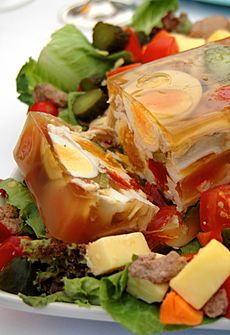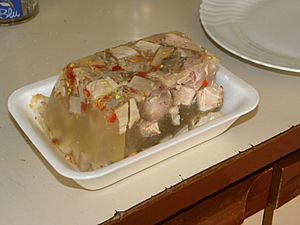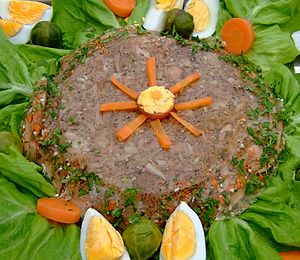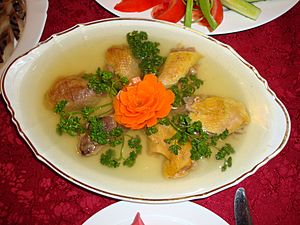Aspic facts for kids
Aspic is a special kind of savory (not sweet) jelly. It's made from a rich meat broth, like a soup base, that turns into a jelly when it cools down. This jelly is often used to hold other foods inside it, like pieces of meat, seafood, or eggs. Think of it like a clear, savory mold that keeps everything together!
Sometimes, people call aspic "aspic gelée" or "aspic jelly." In the United States, you might have heard of "jello salads," which are similar but usually sweet and made with flavored gelatin mixes. Aspic is different because it's all about savory flavors from meat.
Contents
History of Aspic
Aspic has a long history! People have been making dishes like it for a very long time.
Early Beginnings
One of the oldest known cookbooks, called Kitab al-Tabikh, from the 10th century, has a recipe for a fish aspic. This old recipe used fish heads, vinegar, and many spices like ginger and saffron. The saffron made the dish a beautiful "radiant red" color.
By the Middle Ages, cooks had learned that if they boiled meat broth long enough, it would thicken and turn into a jelly. A detailed recipe for aspic can be found in a cookbook called Le Viandier, written around 1375.
Modern Aspic
In the early 1800s, a famous French chef named Marie-Antoine Carême became very creative with aspic. He invented something called chaudfroid. This French word means "hot cold." It was used for foods that were cooked hot but served cold. Aspic was perfect for this, as it added moisture and flavor to cold dishes like fish or chicken. Carême also came up with many new ways to prepare aspic.
Aspic became quite popular in America in the early 1900s. By the 1950s, it was a common dinner item. Cooks enjoyed showing off their skills by making fancy and creative aspic dishes.
What Aspic is Used For
Aspic jelly can be clear or have different shades of amber. It's used for several reasons:
- Protecting Food: Aspic can cover food, keeping air and bacteria away. This helps cooked meat or other ingredients stay fresh for longer.
- Adding Flavor: It gives food more taste.
- Decoration: Aspic makes food look fancy! It can make dishes glisten, giving them a shiny, "lacquered" finish.
- Shaping Food: Aspic can be poured into molds to create different shapes. These shapes can then be used as a garnish for deli meats or other dishes.
There are different types of aspic based on how firm they are. Some are soft and delicate, while others are firm enough to be sliced. Some aspic is made just for decoration and isn't meant to be eaten.
How Aspic is Made
Making aspic involves boiling meat and bones that contain a natural substance called gelatin. When these parts are cooked for a long time, the gelatin dissolves into the water, creating a rich broth.
The Basic Process
- First, meat, bones, or even pig's feet (which have lots of gelatin) are placed in cold water.
- They cook slowly for several hours.
- Then, the broth is allowed to cool. Any extra fat is removed.
- As the broth cools, the natural gelatin in it makes it turn into a jelly.
- Spices, vegetables, or other flavorings can be added to the broth for taste.
Different Meats
Almost any type of food can be set in aspic, and most meats (like chicken, beef, or fish) can be used to make the gelatin.
- Pork and Veal: These meats, especially parts like calf's feet, have a lot of natural gelatin. This makes the aspic set very well.
- Poultry: Chicken or turkey can also be used.
- Fish: Fish broth usually has less natural gelatin. So, extra gelatin might need to be added to make fish aspic set properly. Fish aspic also melts more easily in your mouth because its gelatin melts at a lower temperature.
- Vegetables: Vegetables don't have natural gelatin. However, they can be set in aspic if meat broth is used, or if a plant-based gelling agent like pectin (often used in jams) is added.
Sometimes, the broth is made very clear using egg whites before it's flavored and allowed to set.
Aspic Around the World
Many countries have their own versions of aspic, especially in Eastern Europe.
Pork Jelly
Pork jelly is a very popular type of aspic. It's often made from parts of the pig that have a lot of connective tissue, like trotters (feet). This makes it naturally very jelly-like.
- It's a common appetizer in countries like Croatia, Poland, Czech Republic, Romania, and Ukraine.
- In Russia, Belarus, and Ukraine, it's called kholodets. It's a traditional dish for winter holidays like Christmas and New Year. People often eat it with horseradish or mustard.
- In Vietnam, a similar dish called thịt nấu đông is eaten during the Lunar New Year.
- Pork jelly is also used to preserve meat inside pork pies.
Pihtije (Southeastern Europe)
In countries like Serbia, North Macedonia, and Bulgaria, there's a dish called Pihtije. It's an aspic-like dish usually made from lamb, chicken, or pork, especially parts like the head or shank. It forms a semi-solid, cake-like jelly.
- The meat is boiled, then the bones are removed. The broth is filtered, and the meat and broth are poured into shallow bowls.
- Garlic and sometimes thin slices of tomatoes or peppers are added for decoration.
- It's left in a cold place to turn into a jelly. Good pihtije can be cut into neat cubes "like glass."
- It's often served as an appetizer and is popular during celebrations.
Romanian and Moldovan Piftie
In Romania and Moldova, piftie (or răcitură) is usually made with pork offal (internal organs) boiled with garlic and bay leaves. Pig's trotters are often used because they have so much gelatin. It's traditionally served for the Epiphany holiday.
Jokpyeon (Korea)
In Korea, Jokpyeon is a dish made by boiling beef and pork cuts that are high in collagen, like the head, skin, or tail. The liquid from this long cooking process turns into a jelly when it cools.
Ta Khaa (Nepal)
Among the Newar people in Nepal, buffalo meat jelly, called ta khaa, is an important part of winter celebrations. It's often eaten with fish aspic, which is made from dried fish and buffalo meat broth, spiced and soured.
Kholodets (Eastern Europe)
In Ukrainian, Belarusian, and Russian cooking, a meat aspic dish is called kholodets. The name comes from the word for "cold."
- It's usually made by boiling bones and meat for 5-8 hours to create a rich broth.
- The meat is then separated, minced, mixed back with the broth, and cooled until it becomes a solid jelly.
- Kholodets is usually eaten with horseradish or mustard.
- It's a traditional dish for winter holidays like New Year, but with modern fridges, people enjoy it all year round.
Hladetina (Croatia)
The Croatian version is called hladetina, which means "cold." It can range from a delicate jelly to a firmer type that's more like head cheese.
Žolca (Slovenia)
In Slovenia, aspic is known as žolca or tlačenka. It's traditionally served during Easter.
Sky (Denmark)
In Denmark, aspic is called sky. It's made from meat juices, gelatin, and sometimes mushrooms. Sky is mostly eaten as a topping for cold cuts or special Danish open-faced sandwiches called smørrebrød.
Mujuji (Georgia)
Mujuji is a traditional Georgian dish of cold jellied pork. It includes pork meat, tails, ears, and feet, along with vegetables like carrots and onions, and spices like garlic and bay leaves. It's chilled and served with green onions and herbs.
Images for kids
-
A specialty of northern Thailand, kaeng kradang is a Thai curry aspic.
See also
 In Spanish: Aspic para niños
In Spanish: Aspic para niños









